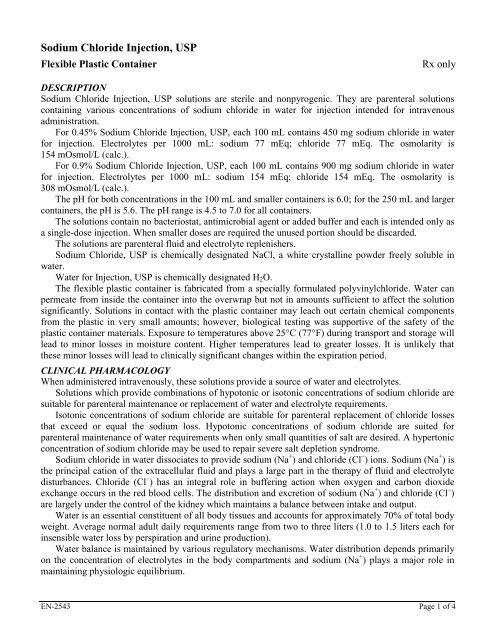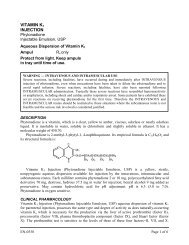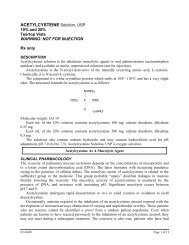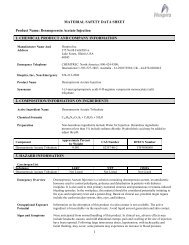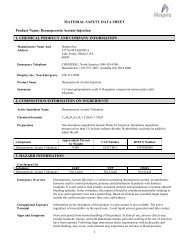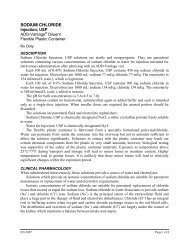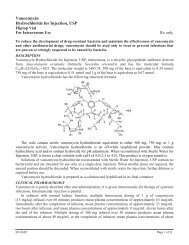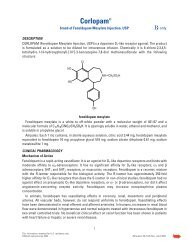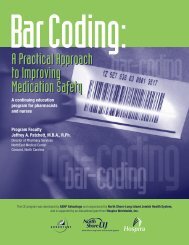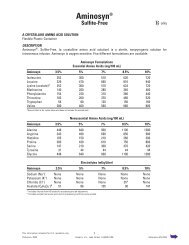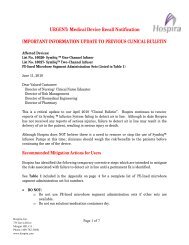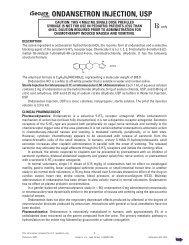0.9% Sodium Chloride Injection, USP - Hospira
0.9% Sodium Chloride Injection, USP - Hospira
0.9% Sodium Chloride Injection, USP - Hospira
Create successful ePaper yourself
Turn your PDF publications into a flip-book with our unique Google optimized e-Paper software.
<strong>Sodium</strong> <strong>Chloride</strong> <strong>Injection</strong>, <strong>USP</strong><br />
Flexible Plastic Container Rx only<br />
DESCRIPTION<br />
<strong>Sodium</strong> <strong>Chloride</strong> <strong>Injection</strong>, <strong>USP</strong> solutions are sterile and nonpyrogenic. They are parenteral solutions<br />
containing various concentrations of sodium chloride in water for injection intended for intravenous<br />
administration.<br />
For 0.45% <strong>Sodium</strong> <strong>Chloride</strong> <strong>Injection</strong>, <strong>USP</strong>, each 100 mL contains 450 mg sodium chloride in water<br />
for injection. Electrolytes per 1000 mL: sodium 77 mEq; chloride 77 mEq. The osmolarity is<br />
154 mOsmol/L (calc.).<br />
For <strong>0.9%</strong> <strong>Sodium</strong> <strong>Chloride</strong> <strong>Injection</strong>, <strong>USP</strong>, each 100 mL contains 900 mg sodium chloride in water<br />
for injection. Electrolytes per 1000 mL: sodium 154 mEq; chloride 154 mEq. The osmolarity is<br />
308 mOsmol/L (calc.).<br />
The pH for both concentrations in the 100 mL and smaller containers is 6.0; for the 250 mL and larger<br />
containers, the pH is 5.6. The pH range is 4.5 to 7.0 for all containers.<br />
The solutions contain no bacteriostat, antimicrobial agent or added buffer and each is intended only as<br />
a single-dose injection. When smaller doses are required the unused portion should be discarded.<br />
The solutions are parenteral fluid and electrolyte replenishers.<br />
<strong>Sodium</strong> <strong>Chloride</strong>, <strong>USP</strong> is chemically designated NaCl, a white crystalline powder freely soluble in<br />
water.<br />
Water for <strong>Injection</strong>, <strong>USP</strong> is chemically designated H2O.<br />
The flexible plastic container is fabricated from a specially formulated polyvinylchloride. Water can<br />
permeate from inside the container into the overwrap but not in amounts sufficient to affect the solution<br />
significantly. Solutions in contact with the plastic container may leach out certain chemical components<br />
from the plastic in very small amounts; however, biological testing was supportive of the safety of the<br />
plastic container materials. Exposure to temperatures above 25°C (77°F) during transport and storage will<br />
lead to minor losses in moisture content. Higher temperatures lead to greater losses. It is unlikely that<br />
these minor losses will lead to clinically significant changes within the expiration period.<br />
CLINICAL PHARMACOLOGY<br />
When administered intravenously, these solutions provide a source of water and electrolytes.<br />
Solutions which provide combinations of hypotonic or isotonic concentrations of sodium chloride are<br />
suitable for parenteral maintenance or replacement of water and electrolyte requirements.<br />
Isotonic concentrations of sodium chloride are suitable for parenteral replacement of chloride losses<br />
that exceed or equal the sodium loss. Hypotonic concentrations of sodium chloride are suited for<br />
parenteral maintenance of water requirements when only small quantities of salt are desired. A hypertonic<br />
concentration of sodium chloride may be used to repair severe salt depletion syndrome.<br />
<strong>Sodium</strong> chloride in water dissociates to provide sodium (Na + ) and chloride (Cl – ) ions. <strong>Sodium</strong> (Na + ) is<br />
the principal cation of the extracellular fluid and plays a large part in the therapy of fluid and electrolyte<br />
disturbances. <strong>Chloride</strong> (Cl – ) has an integral role in buffering action when oxygen and carbon dioxide<br />
exchange occurs in the red blood cells. The distribution and excretion of sodium (Na + ) and chloride (Cl – )<br />
are largely under the control of the kidney which maintains a balance between intake and output.<br />
Water is an essential constituent of all body tissues and accounts for approximately 70% of total body<br />
weight. Average normal adult daily requirements range from two to three liters (1.0 to 1.5 liters each for<br />
insensible water loss by perspiration and urine production).<br />
Water balance is maintained by various regulatory mechanisms. Water distribution depends primarily<br />
on the concentration of electrolytes in the body compartments and sodium (Na + ) plays a major role in<br />
maintaining physiologic equilibrium.<br />
EN-2543 Page 1 of 4
INDICATIONS AND USAGE<br />
Intravenous solutions containing sodium chloride are indicated for parenteral replenishment of fluid and<br />
sodium chloride as required by the clinical condition of the patient.<br />
CONTRAINDICATIONS<br />
None known.<br />
WARNINGS<br />
Solutions containing sodium ions should be used with great care, if at all, in patients with congestive heart<br />
failure, severe renal insufficiency and in clinical states in which there exists edema with sodium retention.<br />
Excessive administration of potassium-free solutions may result in significant hypokalemia.<br />
In patients with diminished renal function, administration of solutions containing sodium ions may<br />
result in sodium retention.<br />
The intravenous administration of these solutions can cause fluid and/or solute overloading resulting<br />
in dilution of serum electrolyte concentrations, overhydration, congested states or pulmonary edema.<br />
The risk of dilutional states is inversely proportional to the electrolyte concentrations of administered<br />
parenteral solutions. The risk of solute overload causing congested states with peripheral and pulmonary<br />
edema is directly proportional to the electrolyte concentrations of such solutions.<br />
PRECAUTIONS<br />
Clinical evaluation and periodic laboratory determinations are necessary to monitor changes in fluid<br />
balance, electrolyte concentrations and acid-base balance during prolonged parenteral therapy or<br />
whenever the condition of the patient warrants such evaluation.<br />
Caution must be exercised in the administration of parenteral fluids, especially those containing<br />
sodium ions to patients receiving corticosteroids or corticotropin.<br />
Do not administer unless solution is clear and container is undamaged. Discard unused portion.<br />
Carcinogenesis, Mutagenesis, Impairment of Fertility: Studies have not been performed with <strong>Sodium</strong><br />
<strong>Chloride</strong> <strong>Injection</strong>, <strong>USP</strong> to evaluate the potential for carcinogenesis, mutagenesis or impairment of<br />
fertility.<br />
Pregnancy: Teratogenic Effects<br />
Pregnancy Category C. Animal reproduction studies have not been conducted with sodium chloride.<br />
It is also not known whether sodium chloride can cause fetal harm when administered to a pregnant<br />
woman or can affect reproduction capacity. <strong>Sodium</strong> chloride should be given to a pregnant woman only if<br />
clearly needed.<br />
Nursing Mothers: Caution should be exercised when <strong>Sodium</strong> <strong>Chloride</strong> <strong>Injection</strong>, <strong>USP</strong> is administered to<br />
a nursing woman.<br />
Pediatric Use: The safety and effectiveness in the pediatric population are based on the similarity of the<br />
clinical conditions of the pediatric and adult populations. In neonates or very small infants the volume of<br />
fluid may affect fluid and electrolyte balance.<br />
ADVERSE REACTIONS<br />
Reactions which may occur because of the solution or the technique of administration include febrile<br />
response, infection at the site of injection, venous thrombosis or phlebitis extending from the site of<br />
injection, extravasation and hypervolemia.<br />
If an adverse reaction does occur, discontinue the infusion, evaluate the patient, institute appropriate<br />
therapeutic countermeasures and save the remainder of the fluid for examination if deemed necessary.<br />
OVERDOSAGE<br />
In the event of overhydration or solute overload, re-evaluate the patient and institute appropriate<br />
corrective measures. (See WARNINGS, PRECAUTIONS, and ADVERSE REACTIONS.)<br />
EN-2543 Page 2 of 4
DOSAGE AND ADMINISTRATION<br />
The dose is dependent upon the age, weight and clinical condition of the patient.<br />
Drug Interactions<br />
Additives may be incompatible. Consult with pharmacist, if available. When introducing additives, use<br />
aseptic technique, mix thoroughly and do not store.<br />
Parenteral drug products should be inspected visually for particulate matter and discoloration prior to<br />
administration, whenever solution and container permit. (See PRECAUTIONS.)<br />
INSTRUCTIONS FOR USE<br />
To Open<br />
Tear outer wrap at notch and remove solution container. If supplemental medication is desired, follow<br />
directions below before preparing for administration. Some opacity of the plastic due to moisture<br />
absorption during the sterilization process may be observed. This is normal and does not affect the<br />
solution quality or safety. The opacity will diminish gradually.<br />
To Add Medication<br />
1. Prepare additive port.<br />
2. Using aseptic technique and an additive delivery needle of appropriate length, puncture resealable<br />
additive port at target area, inner diaphragm and inject. Withdraw needle after injecting medication.<br />
3. The additive port may be protected by covering with an additive cap.<br />
4. Mix container contents thoroughly.<br />
Preparation for Administration<br />
(Use aseptic technique)<br />
1. Close flow control clamp of administration set.<br />
2. Remove cover from outlet port at bottom of container.<br />
3. Insert piercing pin of administration set into port with a twisting motion until the set is firmly seated.<br />
NOTE: See full directions on administration set carton.<br />
4. Suspend container from hanger.<br />
5. Squeeze and release drip chamber to establish proper fluid level in chamber.<br />
6. Open flow control clamp and clear air from set. Close clamp.<br />
7. Attach set to venipuncture device. If device is not indwelling, prime and make venipuncture.<br />
8. Regulate rate of administration with flow control clamp.<br />
WARNING: Do not use flexible container in series connections.<br />
EN-2543 Page 3 of 4
HOW SUPPLIED<br />
<strong>Sodium</strong> <strong>Chloride</strong> <strong>Injection</strong>, <strong>USP</strong> is supplied in single-dose flexible plastic containers in various sizes and<br />
concentrations as shown in the accompanying Table.<br />
NDC No. Product Container<br />
size mL<br />
0409-7730-20 0.45% <strong>Sodium</strong> <strong>Chloride</strong> Inj., <strong>USP</strong> 25<br />
0409-7730-36 0.45% <strong>Sodium</strong> <strong>Chloride</strong> Inj., <strong>USP</strong> 50<br />
0409-7730-37 0.45% <strong>Sodium</strong> <strong>Chloride</strong> Inj., <strong>USP</strong> 100<br />
0409-7985-02 0.45% <strong>Sodium</strong> <strong>Chloride</strong> Inj., <strong>USP</strong> 250<br />
0409-7985-03 0.45% <strong>Sodium</strong> <strong>Chloride</strong> Inj., <strong>USP</strong> 500<br />
0409-7985-09 0.45% <strong>Sodium</strong> <strong>Chloride</strong> Inj., <strong>USP</strong> 1000<br />
0409-7984-20 <strong>0.9%</strong> <strong>Sodium</strong> <strong>Chloride</strong> Inj., <strong>USP</strong> 25<br />
0409-7984-36 <strong>0.9%</strong> <strong>Sodium</strong> <strong>Chloride</strong> Inj., <strong>USP</strong> 50<br />
0409-7984-13 <strong>0.9%</strong> <strong>Sodium</strong> <strong>Chloride</strong> Inj., <strong>USP</strong> 50<br />
0409-7984-37 <strong>0.9%</strong> <strong>Sodium</strong> <strong>Chloride</strong> Inj., <strong>USP</strong> 100<br />
0409-7984-23 <strong>0.9%</strong> <strong>Sodium</strong> <strong>Chloride</strong> Inj., <strong>USP</strong> 100<br />
0409-7983-61 <strong>0.9%</strong> <strong>Sodium</strong> <strong>Chloride</strong> Inj., <strong>USP</strong> 150<br />
0409-7983-02 <strong>0.9%</strong> <strong>Sodium</strong> <strong>Chloride</strong> Inj., <strong>USP</strong> 250<br />
0409-7983-53 <strong>0.9%</strong> <strong>Sodium</strong> <strong>Chloride</strong> Inj., <strong>USP</strong> 250<br />
0409-7983-03 <strong>0.9%</strong> <strong>Sodium</strong> <strong>Chloride</strong> Inj., <strong>USP</strong> 500<br />
0409-7983-55 <strong>0.9%</strong> <strong>Sodium</strong> <strong>Chloride</strong> Inj., <strong>USP</strong> 500<br />
0409-7983-09 <strong>0.9%</strong> <strong>Sodium</strong> <strong>Chloride</strong> Inj., <strong>USP</strong> 1000<br />
Store at 20 to 25°C (68 to 77°F). [See <strong>USP</strong> Controlled Room Temperature.] Protect from freezing.<br />
Revised: June, 2010<br />
Printed in USA EN-2543<br />
<strong>Hospira</strong>, Inc., Lake Forest, IL 60045 USA<br />
EN-2543 Page 4 of 4


